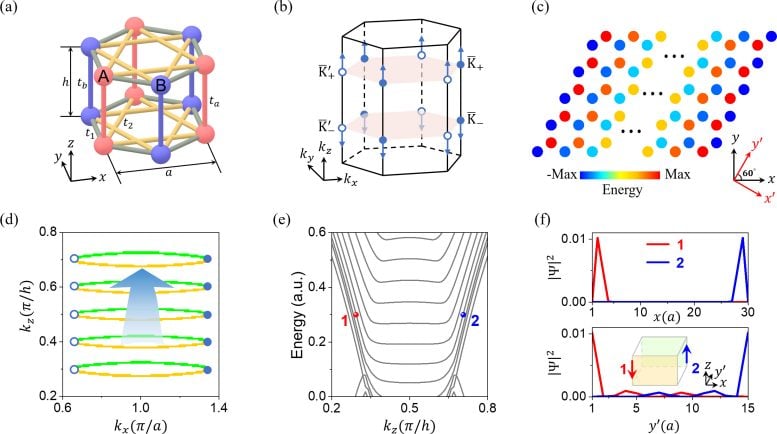Pioneering Study Reveals 3D Quantum Hall Effects in Weyl Acoustic Crystals


Researchers have extended the quantum Hall effect to three dimensions in acoustic waves, using a pseudomagnetic field to observe novel one-dimensional edge states in a 3D printed Weyl crystal. Credit: SciTechDaily.com
A new study has demonstrated the three-dimensional quantum Hall effect in acoustic waves using a Weyl acoustic crystal, marking the first observation of one-dimensional edge states and opening avenues for advanced acoustic device development.
The quantum Hall effect (QHE) stands as a landmark discovery in condensed matter physics, paving the way for the exploration of topological physics. Advancing QHE into three dimensions presents an exciting yet formidable challenge. The complication stems from the fact that, in three dimensions, Landau levels evolve into bands along the magnetic field direction, which obstructs the formation of bulk gaps.
Recently, a feasible scheme has been proposed in Weyl semimetals, whose Fermi arc states on opposite surfaces are connected through the bulk Weyl points to form a complete Fermi loop, and under the magnetic field, one-dimensional edge states are induced on the boundary of the opposite surface. However, the unique edge states have yet to be experimentally observed.
In a new paper published in Science Bulletin, researchers from Shanxi University and Wuhan University of China, theoretically proposed and experimentally demonstrated the three-dimensional QHE for acoustic waves in a Weyl acoustic crystal. In particular, the interesting one-dimensional edge states on the opposite surfaces have been directly observed.

(a) Schematics of the A-A stacking hexagonal lattice. (b) First Brillouin zone and the distribution of the Weyl points. The arrows show their shifts direction by changing the on-site energies of A and B. (c) Inhomogeneous configuration with gradient on-site energy. (d) Equi-energy contours of the surface states at the energy of Weyl points with different on-site energies. (e) Projected dispersions of a parallelogram-shaped structure along the kz direction. (f) Wave function distributions of the edge states. Credit: Science China Press
Pseudomagnetic Field Application
Since the magnetic field has no effect on acoustic waves, a pseudomagnetic field was constructed, whose effect on acoustic waves is similar to that of magnetic fields on electrons. A common strategy for constructing acoustic wave PMFs is to introduce a structural gradient. In this paper, the gradient structure was introduced by varying the acoustic cavities corresponding to the on-site energy. In the process, the Fermi arcs connected the Weyl points simultaneously shifted along the same direction, thereby both the bulk and surface states felt the same pseudomagnetic field. With the pseudomagnetic field, the surface states formed Landau levels, and the one-dimensional edge states were generated and localized near the diagonal hinges.
In the experiment, an acoustic crystal sample was fabricated by using 3D printing technology, and the one-dimensional edge states were directly observed by measuring the acoustic pressure field in the sample.
“This study may open new manners for manipulating acoustic waves, which serves as the basis for acoustic devices with unconventional functions. It provides an ideal and tunable platform to explore the Hall physics, and can extend to other artificial structures, such as the optical and cold atomic systems.” The researchers forecast.
Reference: “Observation of 3D acoustic quantum Hall states” by Xuewei Zhang, Qiang Wei, Mian Peng, Weiyin Deng, Jiuyang Lu, Xueqin Huang, Suotang Jia, Mou Yan, Zhengyou Liu and Gang Chen, 26 April 2024, Science Bulletin.
DOI: 10.1016/j.scib.2024.04.055
The study was funded by the National Key R & D Program of China (Ministry of Science and Technology).



